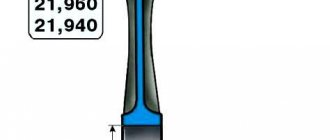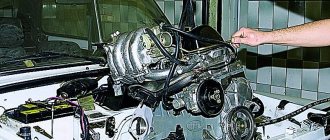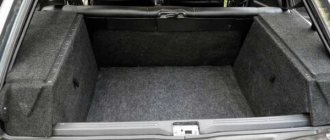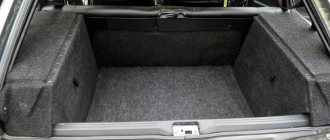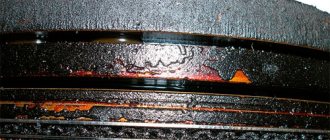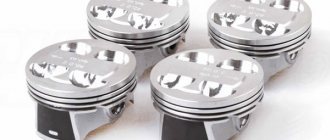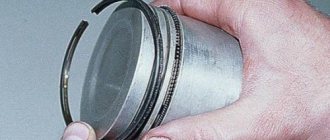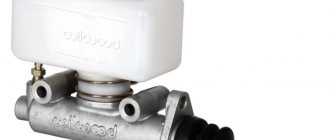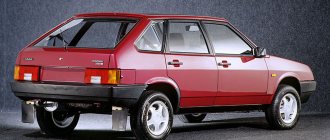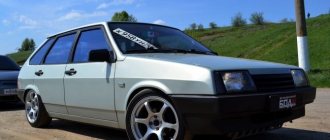1200 rub. for the photo report
We pay for photo reports on car repairs. Earnings from 10,000 rubles/month.
Write:
The marking of pistons allows us to judge not only their geometric dimensions, but also the material of manufacture, production technology, permissible installation gap, manufacturer's trademark, installation direction and much more. Due to the fact that there are both domestic and imported pistons on sale, car owners sometimes face the problem of deciphering certain designations. This material contains as much information as possible, allowing you to obtain information about the markings on the piston and understand what the numbers, letters and arrows mean.
The picture is interactive. When you hover, information about decryption appears
Information on the piston surface
Discussing the question of what markings on pistons mean, it is worth starting with what information the manufacturer puts on the product.
- Piston size . In some cases, in the markings on the bottom of the piston you can find numbers indicating its size, expressed in hundredths of a millimeter. Example - 83.93. This information means that the diameter does not exceed the specified value, taking into account the tolerance (tolerance groups will be discussed below; they differ for different brands of cars). Measurement is carried out at a temperature of +20°C.
- Installation gap . Its other name is temperature (since it can change along with changes in the temperature regime in the engine). Designated as Sp. It is given in fractional numbers, meaning millimeters. For example, the marking on the SP0.03 piston indicates that the gap in this case should be 0.03 mm, taking into account the tolerance range.
- Trademark . Or an emblem. In this way, manufacturers not only identify themselves, but also provide information to craftsmen about whose documentation (product catalogs) should be used when selecting a new piston.
- Installation direction . This information answers the question - what does the arrow on the piston point to? It “tells” how the piston should be mounted, in particular, the arrow is drawn in the direction of forward movement of the car. On cars where the engine is located at the rear, instead of an arrow, a symbolic crankshaft with a flywheel is often depicted.
- Casting number . These are numbers and letters that schematically indicate the geometric dimensions of the piston. Typically, such designations can be found on European machines, for which the piston group elements are manufactured by companies such as MAHLE, Kolbenschm >
In addition to these designations, there are also others, and they may differ from one manufacturer to another.
Modifications
If the 2108 engine, according to the contract, was developed by German craftsmen, then its two modifications, 1.1 liters and 1.5 liters, were finalized by domestic designers:
- 21081 – gasoline consumption is reduced to 5.7 liters in the combined cycle, cylinder 76 mm in diameter, piston stroke 60.6 mm;
- 21083 – piston stroke 71 mm, cylinder diameter 82 mm, torque 100 Nm.
Modification 21083
In the first version, the cylinder head was lowered by 5.5 mm, and the maximum speed of the vehicle dropped to 140 km/h. This modification was created for export cars with restrictions on the volume of internal combustion engines of small cars (Belgium and Portugal).
The second modification was recognized as the most successful, allowing for increased power. Factory tuning is always preferable to changing the design yourself; major repairs do not have to be done more often.
VAZ pistons marking
According to statistics, owners or engine repair technicians of VAZ cars are most often interested in the marking of repair pistons. Below we provide information on various pistons.
VAZ 2110
For example, let's take the engine of a VAZ-2110 car. Most often, this model uses pistons marked 1004015. The product is produced directly at AvtoVAZ OJSC. Brief technical information:
- nominal piston diameter - 82.0 mm;
- piston diameter after first repair - 82.4 mm;
- piston diameter after the second repair - 82.8 mm;
- piston height - 65.9;
- compression height - 37.9 mm;
- The recommended clearance in the cylinder is 0.025...0.045 mm.
Additional information can be printed directly on the piston body. For example:
- “21” and “10” in the area of the hole for the finger - designation of the product model (other options - “213” indicates the VAZ 21213 engine, and for example, “23” - VAZ 2123);
- “VAZ” on the inside of the skirt is the manufacturer’s designation;
- letters and numbers on the inside of the skirt are a specific designation of foundry equipment (you can decipher it using the manufacturer’s documentation, but in most cases this information is useless);
- “AL34” on the inner side of the skirt is the designation of the cast alloy.
The main marking symbols applied to the piston crown:
- The arrow is an orientation marker indicating the direction towards the camshaft drive. On the so-called “classic” VAZ models, sometimes instead of an arrow you can see the letter “P”, which means “in front”. Likewise, the edge where the letter is depicted should be directed towards the direction of movement of the car.
- One of the following symbols is A, B, C, D, E. These are diameter class markers that show the deviation in the outside diameter value. Below is a table with specific values.
- Piston mass group markers. “G” is normal weight, “+” is weight increased by 5 grams, “-” is weight decreased by 5 grams.
- One of the numbers is 1, 2, 3. This is a piston pin hole class marker that determines the deviation in the diameter of the piston pin hole. In addition to this, there is a color designation for this parameter. So, the paint is applied to the inside of the bottom. Blue color - 1st grade, green - 2nd grade, red - 3rd grade. The following provides additional information.
For VAZ repair pistons there are also two separate designations:
- triangle - first repair (diameter increased by 0.4 mm from the nominal size);
- square - second repair (diameter increased by 0.8 mm from the nominal size).
Please note that for different brands of cars (including for different engines), the difference between repair pistons should be found in the reference information.
VAZ 21083
Another popular VAZ piston is 21083-1004015. It is also produced at OJSC AvtoVAZ. Its technical dimensions and parameters:
- nominal diameter - 82 mm;
- diameter after first repair - 82.4 mm;
- diameter after the second repair - 82.8 mm;
- piston pin diameter - 22 mm.
Decarbonization of piston rings
If the engine starts to smoke, there is a possibility that there are rings stuck in the piston grooves. Nowadays, there are many different modern means for decarbonizing piston rings, and many drivers use them to restore engine performance. Among the most popular compositions are:
Motorists believe that if the engine starts smoking, you need to use a decarbonizer, and the engine will work as before, without oil consumption and without smoke. Indeed, sometimes these remedies help, but only in cases where the motor has stood motionless for a long time (for example, after winter), and moisture has accumulated in it. If the car is subject to long-term preservation (put in a garage for winter storage), you should remove the spark plugs and pour oil into the cylinders, and plug the spark plug holes with plugs. With such prevention, the spark plugs will not become damp and rust will not accumulate on the sleeves.
But if, after all, a forgetful car owner has not taken preventive measures, you can use a decarbonizer. We get rid of rust in cylinders as follows:
- pull off high-voltage wires;
- unscrew all spark plugs;
- rotate the crankshaft so that all pistons are in the middle position;
- pour 45 ml of liquid into each cylinder, install spark plugs; leave the cylinders to “soak” for 6-7 hours;
- why do we turn out the spark plugs, turn the starter a few revolutions so that all the dirt flies out of the engine;
- We put the removed parts back in place and start the engine. At first it may smoke a lot, but then the smoke will go away.
Car owners should remember that decarbonization is not a panacea for all ills, and if the piston rings are worn out, then only replacing them will help.
If you find an error, please select a piece of text and press Ctrl+Enter.
Marking of ZMZ pistons
Another category of car owners interested in piston markings have ZMZ brand motors at their disposal. They are installed on GAZ cars - Volga, Gazelle, Sobol and others. Let's look at the symbols on their bodies.
The designation “406” means that the piston is intended for installation in the ZMZ-406 engine. There are two markings stamped on the piston crown. According to the letter painted on the new block, the piston is matched to the cylinder. When repairing with cylinder boring, the required clearances are made during the process of boring and honing for pre-purchased pistons with the required size.
The Roman numeral on the piston indicates the correct piston pin group. The diameters of the holes in the piston bosses, the connecting rod head, as well as the outer diameters of the piston pin are divided into four groups, marked with paint: I - white, II - green, III - yellow, IV - red. On the fingers, the group number is also marked with paint on the inner surface or on the ends. It must match the group indicated on the piston.
The group number should similarly be marked with paint directly on the connecting rod. In this case, the mentioned number must either coincide or be next to the number of the finger group. This selection ensures a situation where the lubricated pin moves with little effort in the connecting rod head, but does not fall out of it. Unlike VAZ pistons, where the direction is indicated by an arrow, on ZMZ pistons the manufacturer directly writes the word “FRONT” or simply puts the letter “P”. During assembly, the protrusion on the lower head of the connecting rod must coincide with this inscription (be on the same side).
There are five groups, with a pitch of 0.012 mm, which are designated by the letters A, B, C, D, D. These size groups are selected according to the outer diameter of the skirt. They correspond to:
- A - 91.988...92.000 mm;
- B - 92,000...92,012 mm;
- B - 92.012...92.024 mm;
- G - 92.024...92.036 mm;
- D - 92.036...92.048 mm.
The value of the piston group is stamped on its bottom. So, there are four size groups, which are marked with paint on the piston bosses:
- 1 - white (22.0000...21.9975 mm);
- 2 - green (21.9975...21.9950 mm);
- 3 - yellow (21.9950...21.9925 mm);
- 4 - red (21.9925...21.9900 mm).
Pin hole group marks can also be applied to the piston bottom in Roman numerals, with each digit corresponding to its own color (I - white, II - green, III - yellow, IV - red). The size groups of the selected pistons and piston pins must match.
The ZMZ-405 engine is installed on the GAZ-3302 “Gazelle Business” and GAZ-2752 “Sobol” vehicles. The calculated gap between the piston skirt and the cylinder (for new parts) should be 0.024...0.048 mm. It is defined as the difference between the minimum cylinder diameter and the maximum piston skirt diameter. There are five groups, with a pitch of 0.012 mm, which are designated by the letters A, B, C, D, D. These size groups are selected according to the outer diameter of the skirt. They correspond to:
- A - 95.488...95.500 mm;
- B - 95.500...95.512 mm;
- B - 95.512...95.524 mm;
- G - 95.524...95.536 mm;
- D - 95.536...95.548 mm.
The value of the piston group is stamped on its bottom. So, there are four size groups, which are marked with paint on the piston bosses:
- 1 - white (22.0000...21.9975 mm);
- 2 - green (21.9975...21.9950 mm);
- 3 - yellow (21.9950...21.9925 mm);
- 4 - red (21.9925...21.9900 mm).
Thus, if, for example, the letter B is written on the piston of a GAZ engine, this means that the engine has been overhauled twice.
In ZMZ 409, almost all dimensions are the same as in ZMZ 405, with the exception of the recess (puddle), it is deeper than in 405. This is done to compensate for the compression ratio, the size h increases on the pistons 409. Also, the compression height of 409 is 34 mm, and for 405 it is 38mm.
We provide similar information for the ZMZ 402 engine.
- A - 91.988...92.000 mm;
- B - 92,000...92,012 mm;
- B - 92.012...92.024 mm;
- G - 92.024...92.036 mm;
- D - 92.036...92.048 mm.
“Selective selection” inscription on pistons
- 1 - white; 25.0000…24.9975 mm;
- 2 - green; 24.9975…24.9950 mm;
- 3 - yellow; 24.9950…24.9925 mm;
- 4 - red; 24.9925…24.9900 mm.
Please note that since October 2005, on pistons 53, 523, 524 (installed on many models of ZMZ engines, among others), the “Selective Selection” seal is installed on their bottom. Such pistons are manufactured using more advanced technology, which is described separately in the technical documentation for them.
| Piston brand ZMZ | Marking applied | Where is the designation applied? | Lettering method |
| 53-1004015-22; 523.1004015; 524.1004015; (410.1004014). | Trademark ZMZ | On the hub near the piston pin hole | Casting |
| Piston model designation | On the hub near the piston pin hole | Casting | |
| "Before" | On the hub near the piston pin hole | Casting | |
| Piston diameter markings A, B, C, D, D. | On the piston bottom | Etching | |
| BTK stamp | On the piston bottom | paint | |
| Finger diameter marking (white, green, yellow) | On a weight lug | paint |
Typical faults
Since the transmission of rotation is carried out by a toothed belt, if it breaks, the motor is guaranteed to bend the valve. By default, the 2108 engine has the following “diseases”:
- poor valve cover design - periodic replacement of the gasket is required;
- low service life of cooling system components - the pump and hoses should be changed frequently;
- detonation - the problem is solved by the use of high-quality fuel;
- Solex carburetor - replacement with Ozone modifications.
Valve cover
But the 2108 engine is not picky about the quality of the lubricant - it is not so important for the owner which engine oil to use.
Toyota pistons markings
The pistons on Toyota engines also have their own designations and sizes. For example, on the popular Land Cruiser, the pistons are designated by the English letters A, B and C, as well as numbers from 1 to 3. Accordingly, the letters indicate the size of the hole for the piston pin, and the numbers indicate the size of the piston diameter in the “skirt” area. The repair piston has +0.5 mm compared to the standard diameter. That is, only the letter designations change for repair shops.
Please note that when purchasing a used piston, it is necessary to measure the thermal gap between the piston skirt and the cylinder wall. It should be within 0.04...0.06 mm. Otherwise, it is necessary to carry out additional diagnostics of the engine and, if necessary, carry out repairs.
Engine piston rings
In an internal combustion engine (ICE), piston rings (PR) serve as a seal between the cylinder walls (liners) and the piston, due to which compression is created in the cylinders. If you forget to put the PC into the engine during assembly, the engine will not start, since the necessary compression of the working air-fuel mixture will not be ensured.
In passenger cars, three rings are standardly installed on each piston - two compression rings and one oil scraper ring, and oil scraper rings can be stacked, that is, consist of several elements. Compression piston rings (CPRs) are used to create compression in the cylinders and are always made of high-strength cast iron with various additives. The upper CPC has the greatest strength, since it operates in the most severe temperature conditions and experiences maximum loads.
Engine oil piston rings (OPRs) are needed to drain oil from the cylinder walls; if the rings do not perform their function, the engine will consume oil. MPKs can be either cast iron or steel, and cast iron PCs are almost always made in one piece, but steel oil scraper rings can only be assembled (composite). Steel MPC for one cylinder consists of:
- two spring steel rings;
- axial expander;
- radial expander.
STK against the Chinese and Americans
Engine piston: design, functions, causes of wear and ways to prevent it
Plugless pistons (we will tell you what they are a little later in this article) manufactured by Samara Trading Company LLC (STK company) are the most popular among experienced and competent mechanics and are considered the most effective.
We have already discussed this topic here, but there is every reason to delve deeper into this issue. Chinese pistons turn out to be quite adapted to our fuel, but they are too unreliable, the quality of the alloys leaves much to be desired: it seems that someone whispered to the Chinese engineers that duralumin slag is better than Soviet steel, cast iron and aluminum. This is wrong.
American pistons, including the famous Federal Mogul, are made a little better, unlike Chinese products. They even provided different groups, but they do not have repair sizes at all. The factory did not provide for this, so they are virtually useless in solving many problems.
A test drive of domestic cars with pistons proved that the dynamic characteristics of cars after replacing the piston group are most productive precisely after replacing them with STK pistons. In other words, torque, compression, exhaust gas quality, oil level, acceleration dynamics, speed and speed of engines on STK remain the same 30-50 thousand kilometers after replacement. No brand of pistons has yet shown such a result.
Let's talk a little more seriously about STK plugless pistons. What are their design and main advantages?
The most unpleasant thing that has probably happened to every motorist is a torn timing belt. There is only one sure way to protect yourself from such a nuisance - replacing the piston group with a good group and setting it up correctly. How to protect yourself from belt breaks and, as a result, bent valves? There is one trick - these are special grooves on top of the pistons, which the people (and then in official car services) began to call “stickless pistons”.
Tubeless pistons
Let's talk in more detail about the grooves on the top of the piston group, which are used by the manufacturing team from STC. So, how does all this work and is there a need to install such pistons on your car? Or can you go with the usual ones and not bother yourself with innovations? Well, let's describe the STK piston itself.
Housing and structure
Such pistons are an almost exact copy of a regular car piston, with only one distinctive feature - in the upper part, instead of the usual “mirror,” special recesses appear to increase the service life of both some timing parts and the pistons themselves.
Recesses of plugless pistons
